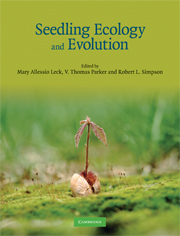Book contents
- Frontmatter
- Contents
- Contributors
- Foreword by Peter J. Grubb
- Preface
- Acknowledgments
- Part I Introduction
- Part II Seedling diversity
- Chapter 2 Seedling natural history
- Chapter 3 Specialized seedling strategies I: seedlings in stressful environments
- Chapter 4 Specialized seedling strategies II: orchids, bromeliads, carnivorous plants, and parasites
- Part III Seedling morphology, evolution, and physiology
- Part IV Life history implications
- Part V Applications
- Part VI Synthesis
- References
- Index
Chapter 3 - Specialized seedling strategies I: seedlings in stressful environments
Published online by Cambridge University Press: 05 June 2012
- Frontmatter
- Contents
- Contributors
- Foreword by Peter J. Grubb
- Preface
- Acknowledgments
- Part I Introduction
- Part II Seedling diversity
- Chapter 2 Seedling natural history
- Chapter 3 Specialized seedling strategies I: seedlings in stressful environments
- Chapter 4 Specialized seedling strategies II: orchids, bromeliads, carnivorous plants, and parasites
- Part III Seedling morphology, evolution, and physiology
- Part IV Life history implications
- Part V Applications
- Part VI Synthesis
- References
- Index
Summary
Introduction
Seedlings are particularly susceptible to harsh conditions. Indeed, the seedling stage is considered to be the most vulnerable stage in the life of the plant (Stebbins, 1971; Fenner, 1987; Fenner & Thompson 2005) because even small reductions in biomass may lead to the death of the plant (Dirzo, 1985; Fenner & Thompson, 2005). Selection has favored strategies that reduce the high risk of the seedling stage primarily in two ways: first, maternal deployment of optimal amount of reserves to ensure maximum likelihood of seedling survival (Smith & Fretwell, 1974; Westoby et al., 1992; Leishman & Westoby, 1994a; Leishman et al., 2000), and second, timing of germination to avoid emergence during periods of high environmental stress as well as during transient favorable conditions too short to ensure postemergence survivorship (Grime, 1979; Baskin & Baskin, 1989, 1998; Fenner & Thompson, 2005). However precise the mechanism to adjust germination to low-risk conditions may be, many environments present inherently high risks for seedlings because the stress is chronic or favorable conditions are intermittent and uncertain (see Table 3.1). Because the ability of the seedling to accumulate or replace biomass decreases as the environment becomes less favorable, seedlings in stressful environments are at higher risk of mortality. Furthermore, when postemergence mortality is highly probable, avoidance of stress per se is not a viable strategy and seedlings are selected to tolerate stressful conditions.
- Type
- Chapter
- Information
- Seedling Ecology and Evolution , pp. 56 - 78Publisher: Cambridge University PressPrint publication year: 2008
- 10
- Cited by



